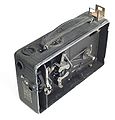
Cine-Kodak
Encyclopedia

Later 16mm Models
In 1929, a Model BB for 50-ft reels was introduced, followed by the Model K in 1930, which was an enlarged BB for 100-ft reels. The Model K was joined briefly by a stripped-down Model M, but the latter camera did not sell well since it lacked some of the very features that made the Model K appealing. In 1933, the Cine-Kodak Special was introduce for advanced amateur and semi-professional work, and quickly became popular with professionals for its vast range of capabilities. The Cine-Kodak Special was slightly modified in 1948 and became the Special II.The mid-30's saw the beginning of a line of magazine-loading cameras, the Magazine Cine-Kodaks, made initially in Kodak's Nagel Works in Germany.
In 1937, the Model E was introduced with a shape similar to the later Pathe Webo camera and provided slow motion speeds and an internal viewfinder instead of the open frame types used hitherto. The final 16mm spool loading Cine-Kodak the K100 arrived in 1956 with both turret and non-turret versions.
16mm Cine-Kodaks were well-made, long-lived cameras. Most have double claws and double sprockets and hence require double perf (2R) film in unmodified form. The exceptions are both the Specials and K100 models that were designed for the addition of sound tracks and accept single perf (1R) film.

